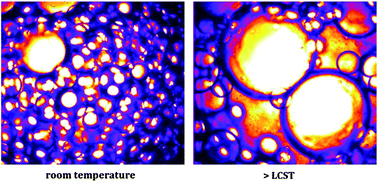The stabilization of liquid–liquid interfaces through the adsorption of surfactants plays an important role in many industrial processes in which emulsions are produced or used. The main aim in the development of new surfactants is to provide prolonged shelf-life by preventing the coalescence of emulsion droplets. While the stability of an emulsion against coalescence is often the main aim in the formulation of emulsion systems, many applications of emulsions do not only require high stability against coalescence, but also the breaking or phase inversion of the emulsion at some point. At first, these requirements seem contradictory: the emulsion needs to be stable on the shelf, yet becomes unstable at some moment under the influence of a given stimulus.
In this context, Sprakel and co-workers approached these contradictory constraints through the synthesis of well-defined thermoresponsive surfactants based on di(ethylene glycol)methacrylate and poly(ethylene glycol)methacrylate using Atom Transfer Radical Polymerization. The surfactants showed a Lower Critical Solution Temperature (LCST) of approximately 34°C, independent of molecular weight, which is ascertained by both Differential Scanning Calorimetry as well as Dynamic Light Scattering. Below the LCST, the surfactants stabilized the emulsions for at least four months. Above this temperature the hydrophilic block collapsed and coalescence between the emulsion droplets occurred; this led to demixing of the sample within several minutes. The authors revealed the mechanism for the temperature-triggered coalescence by measurements of the temperature-dependent interfacial tension and by studying the interfacial morphology of surfactant-covered emulsion droplets.
Well-defined temperature-sensitive surfactants for controlled emulsion coalescence by Huanhuan Feng, Nadine A. L. Verstappen, Alexander J. C. Kuehne and Joris Sprakel, Polym. Chem., 2013, 4, 1842-1847.
Julien Nicolas is a guest web-writer for Polymer Chemistry. He currently works at Univ. Paris-Sud (FR) as a CNRS researcher.











